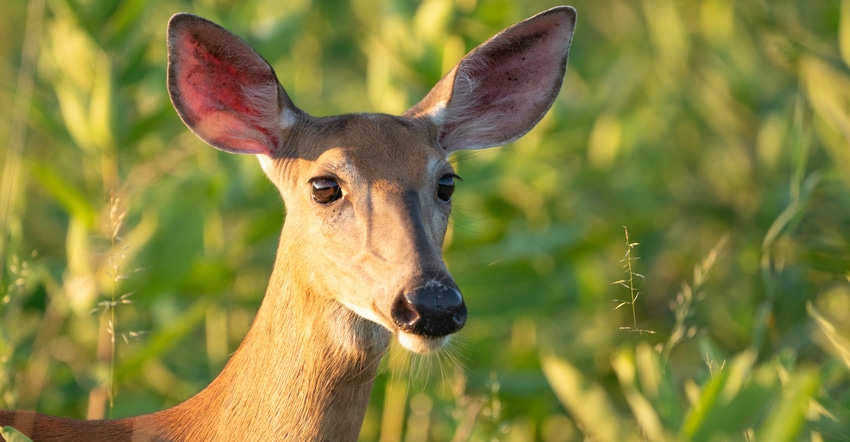June 9, 2021

In response to an increase of farmed deer testing positive for chronic wasting disease, the Minnesota Department of Natural Resources has issued an emergency rule temporarily prohibiting the movement of all farmed white-tailed deer within the state, with the exception of deer being transported to slaughter.
The rule took effect June 1 and ends July 31.
Twelve additional white-tailed deer — five adult does and seven fawns — tested positive for CWD in an infected farmed deer herd in Beltrami County, the Minnesota Board of Animal Health announced May 25.
MBAH first reported this CWD positive herd in April, when a 3-year-old doe tested positive for the disease.
Earlier in May, the remaining 54 animals in the herd were depopulated by the USDA, and samples from each animal were collected and then tested at the USDA National Veterinary Services Laboratories.
The Beltrami County farmed deer herd was initially quarantined in October 2020 due to receiving animals from a Winona County source herd. Among the deer received by the Beltrami County herd was the doe which tested positive for CWD in early April — about one to one-and-a-half years after moving out of the source herd.

HOW IT SPREADS: This diagram, provided by the Minnesota Board of Animal Health, shows how cases of CWD spread from one farmed deer herd to other white-tailed deer in less than a year. CWD-positive animals from Winona County spread CWD to Houston and Beltrami counties. CWD-positive animals in Kanabec County, and then exposed white-tailed deer to the disease in Beltrami, Mille Lacs, Morrison and Mower counties. (Source: MBAH)

During an inspection of the Beltrami County premises following the quarantine of the herd, an MBAH agent discovered several adult deer and fawn carcasses had been moved by the owner to nearby county-managed tax-forfeit land. This spurred an investigation by the board, which has been working with the Department of Natural Resources, the Minnesota Pollution Control Agency, and tribal and local officials, to mitigate any potential spread of CWD from these carcasses.
Fence going up to keep out wild deer
Due to test results that indicate CWD-causing prions are on this site, agencies are currently working with the county to build a fence that would prevent wild deer access to the site and reduce the risk of prion exposure. Prions are abnormal, pathogenic agents in a family of rare progressive neurodegenerative disorders.
The DNR is following its CWD response plan and is planning to test hunter-harvested deer this fall to understand whether CWD is in wild deer in this area. The board’s ongoing investigation will address possible violations of Minnesota animal health laws.
Of the 12 additional CWD-positive animals most recently identified, nine were born on the Beltrami County farm, and three were moved to the farm from other Minnesota herds. These herds are considered to be CWD-exposed, since there is a possibility the animals could have been infected with the disease prior to being moved to Beltrami County.
One of the CWD exposed herds (Winona County) was officially quarantined during the Houston County positive herd investigation. The other two CWD-exposed herds in Hennepin and Kanabec counties were quarantined May 20.
Three additional CWD-exposed herds located in Mille Lacs, Morrison and Mower counties received animals from the Kanabec County herd and were quarantined May 21. The board is working to identify and test animals in all of these CWD-exposed herds that were part of a herd at the same time as a CWD-positive animal.
DNR officials said in a news release that it is fully committed to limiting the spread of CWD in wild deer and to the health of Minnesota’s wild deer herd.
“We firmly believe this situation is urgent and that it requires a comprehensive approach in order to protect the health of Minnesota’s wild deer,” the DNR said. The agency said the state must take a strong, proactive stance to achieve three goals:
• Address the site of the deer remains in Beltrami County.
• Reduce additional risk from Beltrami County through herd quarantine and thorough trace-outs to other herds.
• Move to a more proactive and preventive approach to address systemic gaps in the farmed deer system.
Recognizing the significance of this development, DNR is coordinating with partners at the federal, state and local level to ensure an assertive and nimble response. This includes working with Beltrami County to coordinate containment of the contaminated site on county-managed land where the deer remains were discovered; and working with the Center for Prion Research and Outreach at the University of Minnesota to test the deer remains at the site, as well as nearby soil samples, for presence of CWD prions.
For more information and updates on CWD management, visit the state DNR website's chronic wasting disease page.
Source: The Minnesota Board of Animal Health and the Minnesota Department of Natural Resources, which are solely responsible for the information provided and are wholly owned by the source. Informa Business Media and all of its subsidiaries are not responsible for any of the content contained in this information asset.
You May Also Like




